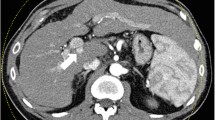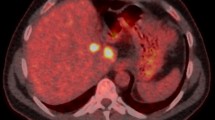Abstract
Background and Aims
Irreversible electroporation (IRE) is a non-thermal ablation technique for unresectable hepatocellular carcinoma (HCC) not amenable to standard thermal ablation. The aim of this study was to report our longer-term outcomes using this treatment modality.
Method
We identified all patients at our institution who underwent IRE for HCC between December 2008 and October 2019 as recommended after multi-disciplinary team review. Demographic, clinical, tumour response and survival data up until 1 March, 2020 were analysed. The primary outcome was local recurrence-free survival (LRFS) in patients who had a complete response (CR). Secondary outcomes included CR rates, procedure-related complications and the incidence of death or liver transplantation.
Results
A total of 23 patients (78% males, median age 65.2 years) received IRE therapy to 33 HCC lesions during the study period with the median tumour size being 2.0 cm (range 1.0–5.0 cm). Twenty-nine (87.9%) lesions were successfully ablated after one (n = 26) or two (n = 3) procedures. The median follow-up time for these lesions was 20.4 months. The median overall LRFS was 34.5 (95% CI 24.8 -) months with a 6- and 12-month LRFS of 87.9% (95% CI 75.8–100) and 83.6% (95% CI 70.2–99.7), respectively. Tumours < 2 cm had a 12-month LRFS of 100% (95% CI 100–100).
Conclusion
IRE appears to be an efficacious local ablative method for early stage HCC not amenable to standard ablative techniques, with very good CR rates and longer-term LRFS, particularly for smaller lesions. Further studies comparing this technique to more widely accepted ablative methods such as radiofrequency and microwave ablation are warranted.


Similar content being viewed by others
Change history
16 November 2020
An author was inadvertently omitted from the author list. Helen Kavnoudias should be listed as third author. The added author’s name and affiliation are marked by underlines.
References
Villanueva A. Hepatocellular carcinoma. New Engl J Med [Internet]. 2019;380(15):1450–62. https://doi.org/10.1056/NEJMra1713263.
World Health Organization. Projections of mortality and causes of death, 2016 to 2060 [Internet]. n.d. Available from: https://www.who.int/healthinfo/global_burden_disease/projections/en/
Forner A, Reig M, Bruix J. Hepatocellular carcinoma. Lancet. 2018;391(10127):1301–14.
Galle PR, Forner A, Llovet JM, Mazzaferro V, Piscaglia F, Raoul J-L, et al. EASL Clinical practice guidelines: management of hepatocellular carcinoma. J Hepatol [Internet]. 2018;69(1):182–236. https://doi.org/10.1016/j.jhep.2018.03.019.
Lencioni R, Crocetti L. Local-Regional treatment of hepatocellular carcinoma. Radiology. 2012;262(1):43–58.
Zimmerman A, Grand D, Charpentier KP. Irreversible electroporation of hepatocellular carcinoma: patient selection and perspectives. J Hepatocell Carcinoma. 2017;4:49–58.
Cheung W, Kavnoudias H, Roberts S, Szkandera B, Kemp W, Thomson KR. Irreversible electroporation for unresectable hepatocellular carcinoma: Initial experience and review of safety and outcomes. Technol Cancer Res T. 2012;12(3):233–41.
Marrero JA, Kulik LM, Sirlin CB, Zhu AX, Finn RS, Abecassis MM, et al. Diagnosis, staging, and management of hepatocellular carcinoma: 2018 Practice Guidance by the American Association for the Study of Liver Diseases. Hepatology. 2018;68(2):723–50.
Lencioni R, Llovet JM. Modified RECIST (mRECIST) assessment for hepatocellular carcinoma. Semin Liver Dis. 2010;30(01):052–60.
Ball C, Thomson KR, Kavnoudias H. Irreversible electroporation. Anesthesia Analgesia. 2010;110(5):1305–9.
The Cancer of the Liver Italian Program (Clip) 1998 Investigators A new prognostic system for hepatocellular carcinoma: A retrospective study of 435 patients. Hepatology: 28(3):751–5 https://doi.org/10.1002/hep.510280322
Fong ZV, Tanabe KK. The clinical management of hepatocellular carcinoma in the United States, Europe, and Asia: a comprehensive and evidence-based comparison and review. Cancer. 2014;120(18):2824–38.
Violi NV, Duran R, Guiu B, Cercueil J-P, Aubé C, Digklia A, et al. Efficacy of microwave ablation versus radiofrequency ablation for the treatment of hepatocellular carcinoma in patients with chronic liver disease: a randomised controlled phase 2 trial. Lancet Gastroenterology Hepatology. 2018;3(5):317–25.
Lee EW, Thai S, Kee ST. Irreversible electroporation: a novel image-guided cancer therapy. Gut Liver. 2010;4(Suppl. 1):S99.
Cannon R, Ellis S, Hayes D, Narayanan G, Martin RCG. Safety and early efficacy of irreversible electroporation for hepatic tumors in proximity to vital structures. J Surg Oncol. 2013;107(5):544–9.
Scheffer HJ, Nielsen K, de Jong MC, van Tilborg AAJM, Vieveen JM, Bouwman AR, et al. Irreversible electroporation for nonthermal tumor ablation in the clinical setting: a systematic review of safety and efficacy. J Vasc Interv Radiol. 2014;25(7):997–1011.
Niessen C, Igl J, Pregler B, Beyer L, Noeva E, Dollinger M, et al. Factors associated with short-term local recurrence of liver cancer after percutaneous ablation using irreversible electroporation: a prospective single-center study. J Vasc Interv Radiol. 2015;26(5):694–702.
Chan P, McLean C, Chan S, Goh GS. The interaction between irreversible electroporation therapy (IRE) and embolization material using a validated vegetal model: an experimental study. Diagn Interv Radiol [Internet]. 2019;25(4):304–9.
Kalra N, Gupta P, Gorsi U, Bhujade H, Chaluvashetty SB, Duseja A, et al. Irreversible electroporation for unresectable hepatocellular carcinoma: initial experience. Cardiovasc Inter Rad. 2019;42(4):584–90.
Dollinger M, Beyer LP, Haimerl M, Niessen C, Jung E-M, Zeman F, et al. Adverse effects of irreversible electroporation of malignant liver tumors under CT fluoroscopic guidance: a single-center experience. Diagn Interv Radiol. 2015;21(6):471–5.
Zeng J, Liu G, Li Z, Yang Y, Fang G, Li R, et al. The safety and efficacy of irreversible electroporation for large hepatocellular carcinoma. Technol Cancer Res T. 2016;16(1):120–4.
Bhutiani N, Philips P, Scoggins CR, McMasters KM, Potts MH, Martin RCG. Evaluation of tolerability and efficacy of irreversible electroporation (IRE) in treatment of Child-Pugh B (7/8) hepatocellular carcinoma (HCC). Hpb. 2016;18(7):593–9.
Eller A, Schmid A, Schmidt J, May M, Brand M, Saake M, et al. Local control of perivascular malignant liver lesions using percutaneous irreversible electroporation: initial experiences. Cardiovasc Inter Rad. 2015;38(1):152–9.
Granata V, Di Castelguidone EDL, Fusco R, Catalano O, Piccirillo M, Palaia R, et al. Irreversible electroporation of hepatocellular carcinoma: preliminary report on the diagnostic accuracy of magnetic resonance, computer tomography, and contrast-enhanced ultrasound in evaluation of the ablated area. Radiol Med (Torino). 2016;121(2):122–31.
Sugimoto K, Moriyasu F, Kobayashi Y, Saito K, Takeuchi H, Ogawa S, et al. Irreversible electroporation for nonthermal tumor ablation in patients with hepatocellular carcinoma: initial clinical experience in Japan. Jpn J Radiol. 2015;33(7):424–32.
Padia SA, Johnson GE, Yeung RS, Park JO, Hippe DS, Kogut MJ. Irreversible electroporation in patients with hepatocellular carcinoma: immediate versus delayed findings at MR imaging. Radiology. 2016;278(1):285–94.
Thomson KR, Cheung W, Ellis SJ, Federman D, Kavnoudias H, Loader-Oliver D, et al. Investigation of the safety of irreversible electroporation in humans. J Vasc Interv Radiol [Internet]. 2011;22(5):611–21. https://doi.org/10.1016/j.jvir.2010.12.014.
Mafeld S, Wong JJ, Kibriya N, Stenberg B, Manas D, Bassett P, et al. Percutaneous Irreversible Electroporation (IRE) of Hepatic Malignancy: A Bi-institutional Analysis of Safety and Outcomes. Cardiovasc Inter Rad [Internet]. 2019;42(4):577–83.
Wu L-M, Zhang L-L, Chen X-H, Zheng S-S. Is irreversible electroporation safe and effective in the treatment of hepatobiliary and pancreatic cancers? Hepatob Pancreat Dis. 2019;18(2):117–24.
Sutter O, Calvo J, N’Kontchou G, Nault J-C, Ourabia R, Nahon P, et al. Safety and efficacy of irreversible electroporation for the treatment of hepatocellular carcinoma not amenable to thermal ablation techniques: a retrospective single-center case series. Radiology. 2017;284(3):877–86.
Funding
This study was not supported by any funding.
Author information
Authors and Affiliations
Contributions
All authors contributed to the study conception and design. Material preparation, data collection and analysis were performed by Elliot Freeman. The first draft was written by Elliot Freeman and EF, WC, AM, WK, and SKR reviewed earlier versions of the manuscript, with all authors reviewing and approving the final version of the manuscript.
Corresponding author
Ethics declarations
Conflict of interest
The authors declare that they have no conflict of interest.
Ethical Approval
For this type of study, formal consent is not required. The study protocol was approved by the Alfred Hospital Ethics Committee (Project No: 163/20).
Informed Consent
For this type of study, informed consent is not required.
Consent for Publication
For this type of study, consent for publication is not required.
Additional information
Publisher's Note
Springer Nature remains neutral with regard to jurisdictional claims in published maps and institutional affiliations.
The original online version of this article was revised: An author was inadvertently omitted from the author list. Helen Kavnoudias should be listed as third author. The added author’s name and affiliation are marked by underlines. E Freeman1, W Cheung2, H Kavnoudias2, A Majeed1,3, W Kemp13, SK Roberts1,3 2Department of Radiology, Alfred Hospital, Melbourne, Australia
Rights and permissions
About this article
Cite this article
Freeman, E., Cheung, W., Kavnoudias, H. et al. Irreversible Electroporation For Hepatocellular Carcinoma: Longer-Term Outcomes At A Single Centre. Cardiovasc Intervent Radiol 44, 247–253 (2021). https://doi.org/10.1007/s00270-020-02666-4
Received:
Accepted:
Published:
Issue Date:
DOI: https://doi.org/10.1007/s00270-020-02666-4




